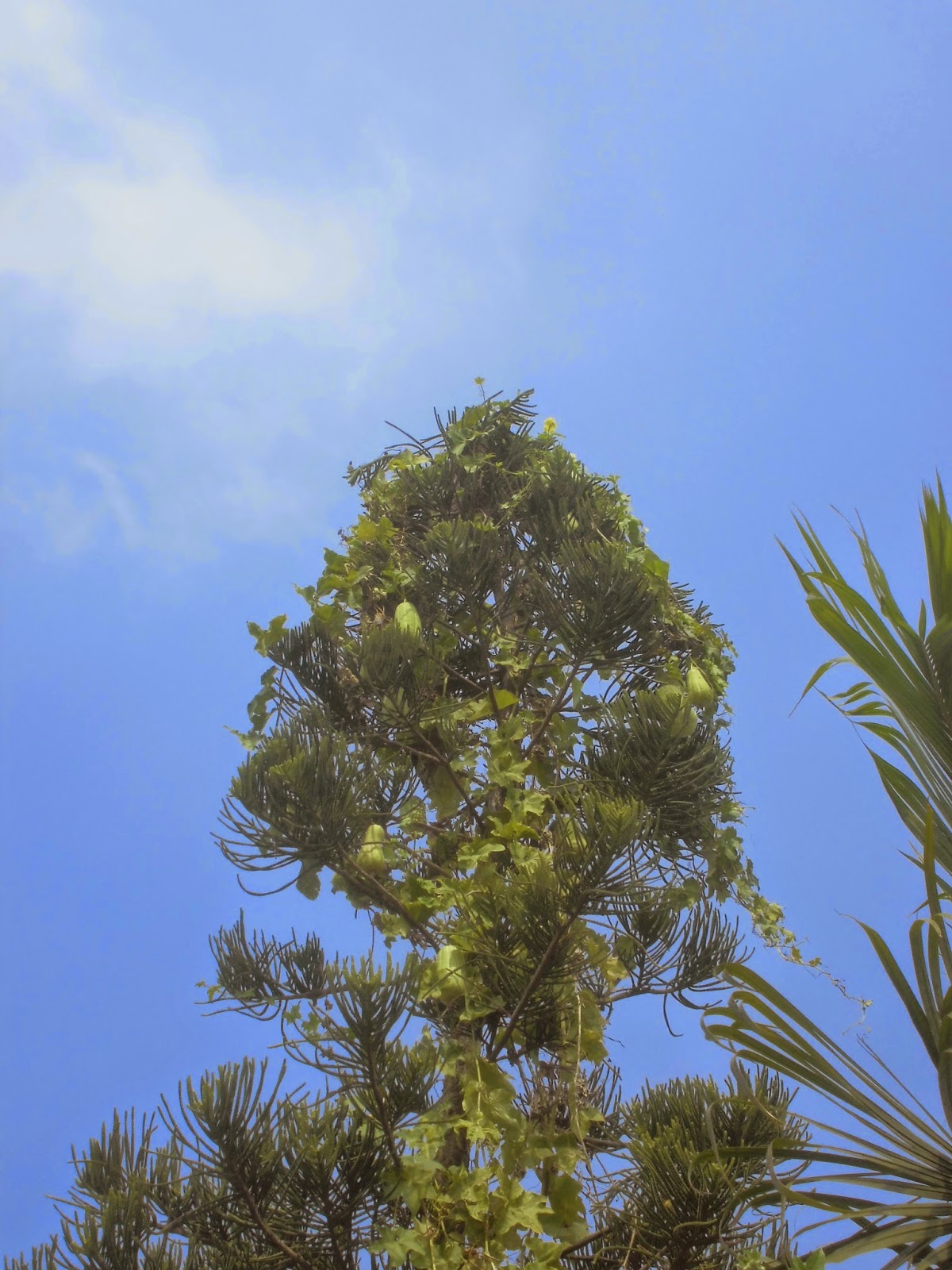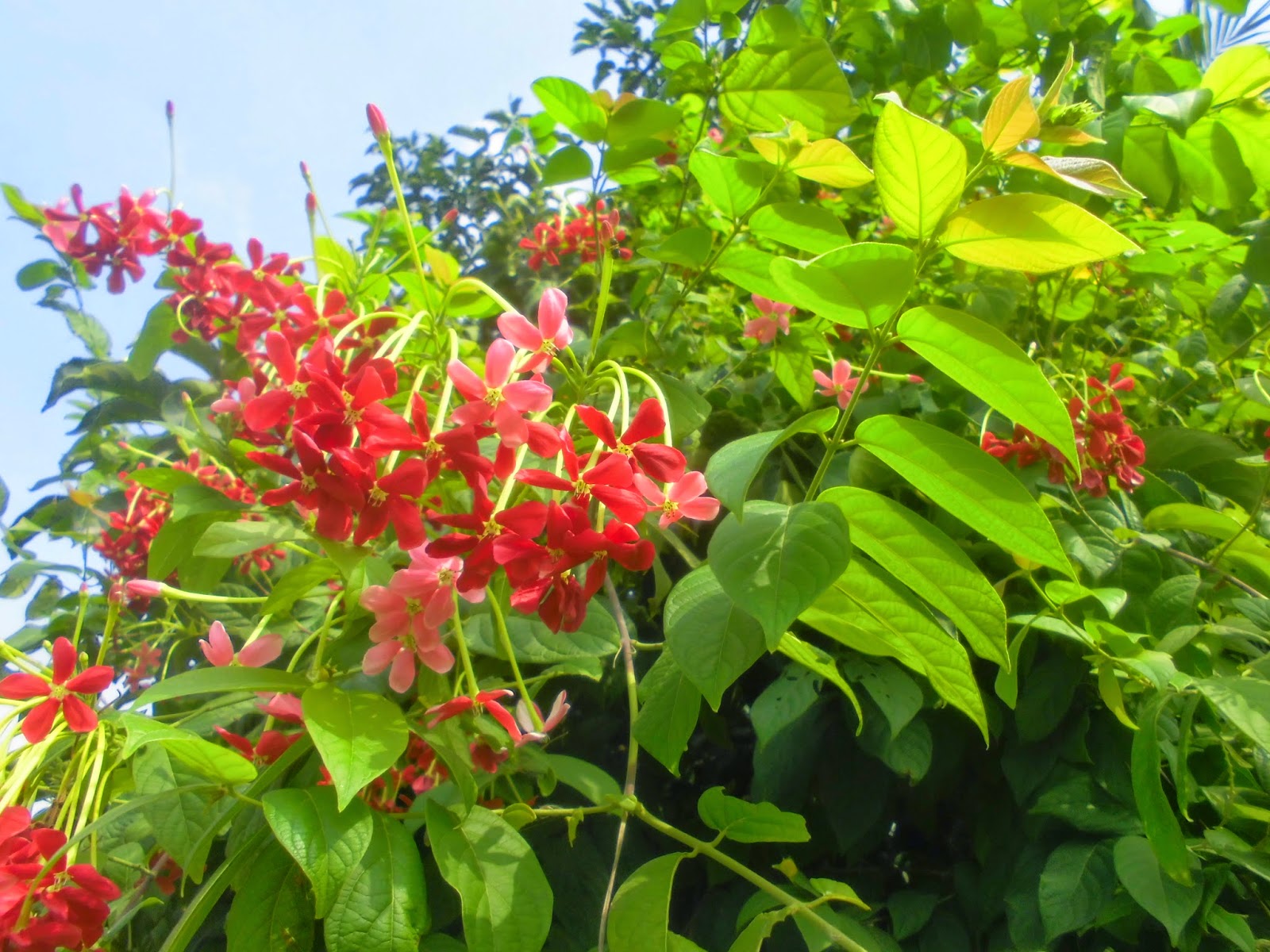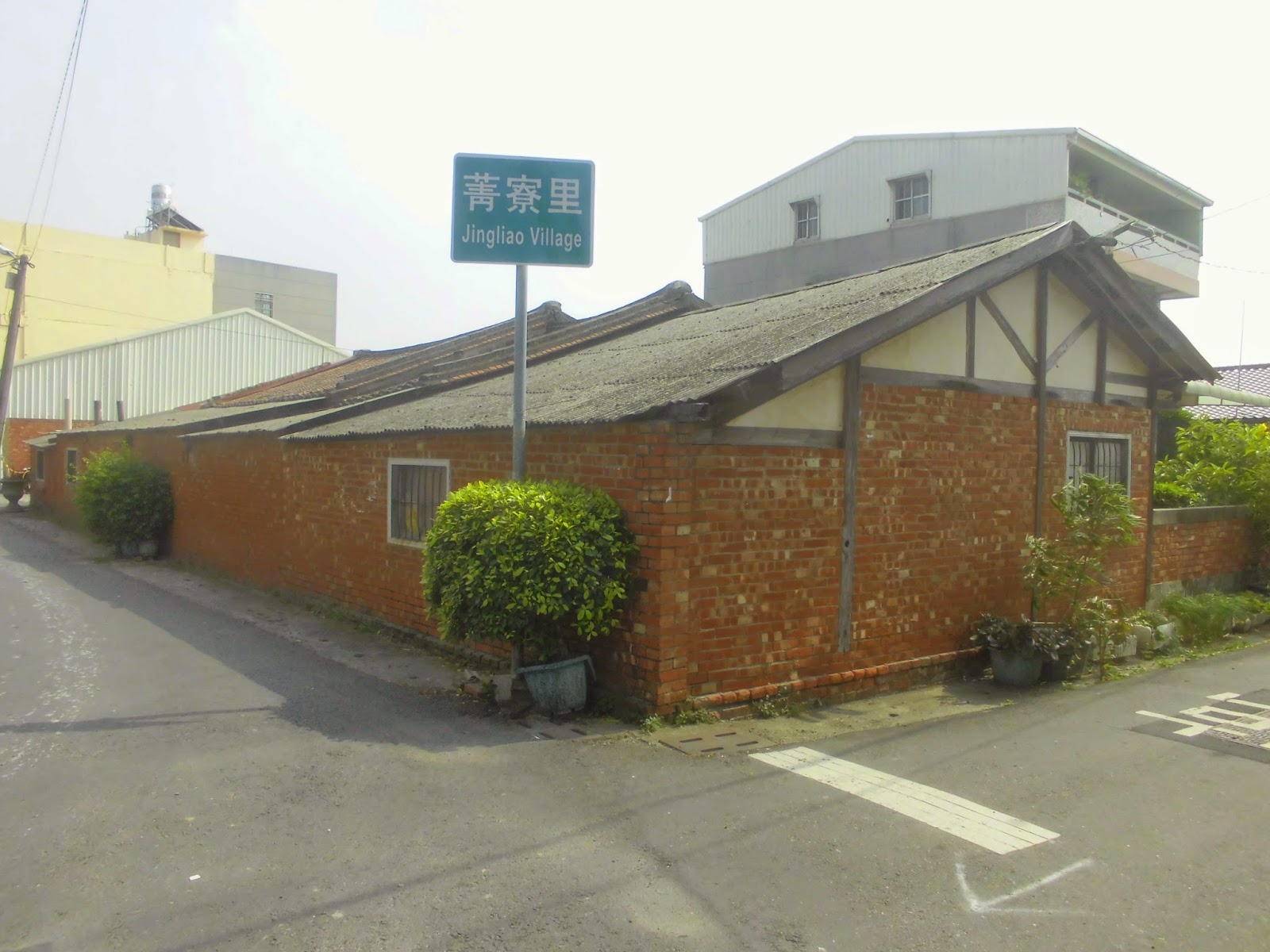The next thing we did in Wumile was to walk around the town on the designated tourist walking route that they've made. It takes you away from the town center a bit.
無米楽で最後にやったことは町の周辺を回る遊歩道を歩いた。
無米樂有一條遊步道。可以走一走看無米樂周邊的地方。
I thought the designs on this building were interesting, if a little odd.
この建物の模様が面白い。
又奇怪又有趣的彩繪。
A Vietnamese Luffa Tree!?! Ah, I see. The Luffa vine is just growing up the tree is all. (Luffa don't grow on trees, so this sight surprised me when I first saw it.)ヘチマの木かと思ったけど、それはあり得ない。(ヘチマは木じゃないから。)ヘチマが木を登っているだけ。
一看到我就以為這棵是一棵絲瓜樹。但是絲瓜應該不是樹。後來我注意到只是絲瓜藤生長在樹上。
A map showing the four little temples in town related to the cardinal directions. In Feng Shui, the four cardinal directions are associated with different attributes. Each one has an animal and a color that represents it.
風水の考え方にしたがって、無米楽に廟が東西南北ある。
按照風水的理念,無米樂有四座南北西東的小廟。
This is one of the above mentioned temples.
A "Sanheyuan" (sahn-huh-yoowhen) house is a traditional Fujinese house that is also often seen in Taiwan since the ancestors of most Taiwanese people came from Fujian. "San" means "three", and the name refers to the fact that the house is shaped like three walls surrounding a central courtyard. (There are also "four" houses where the house is shaped like a square with an open courtyard in the center that is completely blocked off from the outside world.) The sign also explains that there are a number of these traditional houses preserved in Wumile.
「三合院」というのは福建の伝統的な民家のことだ。家が三つの塀みたいな感じになって、真ん中に広場がある。ちなみに、「四合院」もある。その場合は真ん中の広場は完全に家に囲まれて外の世界と隔離している。無米楽に三合院がたくさん保存されている。
interesting tile work
面白いタイル
我喜歡這樣的瓷磚。
*mro~wr*
A poster for some sort of festival related to Mazu at a local temple. It shows two dates because they've put the Gregorian calendar date as well as the lunar calendar date. Taiwan makes good use of both calendars because while they have adapted the western calendar for many official purposes, the lunar calendar is still important for determining the dates of various religious festivals and observances. Most date books will have both calendars noted.
台湾は日本と違って現在も旧暦がよく使われている。手帳などには基本的に西暦も旧暦も書いてある。廟の祭日は全部旧暦によって日が決まっている。下のポスターに日付が二つあるのはその訳がある。
豐富多彩廟活動的廣告。西曆,農曆都有是有趣點。我以前住在日本,現在除了沖繩以外農曆都用不到了。(我聽說沖繩有的地方還是看農曆決定俗民節日。)這是因為明治時代日本決定把農曆廢除,開始用西曆。跟日本比起來在鄰國台灣農曆還是很常用。
There was a large chicken coop along the way.
鶏を飼っている家があった。
有人養雞
For some reason there was this poster showing the 24 "sections" of the year. This is a traditional, Chinese way of breaking up the year based on the sun's movements. Basically, you have the two solstices and the two equinoxes, and then you have the dates half way in between the solstices and equinoxes, and then you keep dividing until you have 24 parts. This calendar also shows what farming activities are engaged in on what dates.
24節気がなぜか大きな看板に書いてあった。その時の活動も書いている。さすが亜熱帯の台湾、二期作ができるので、「育苗期」などが二回出てくる。
在路旁我看到這個二十四節氣的標誌。
a papaya tree
パパイアの木
木瓜
???
A "Shigandang" stone. Usually they are at street intersections. I don't know why this one is surrounded by a little wall like this.
石敢当があった。でも交差点にあったんじゃなくて、こういうふうに祀られている。
石敢當。這一個不是在交叉點。不常看到這樣的情況。好像它變成拜拜的焦點。
I noticed a praying mantis on the stone and followed its movements.
カマキリ発見!
在石敢當上有一隻螳螂。
Oh god, it saw me!
ヤバい、こっち見とる、、、
注意到了我!
And here's where it jumped at my camera and attacked me. In pulling my hand away, I also accidentally pushed the shutter button.
急にカメラに飛んで来た。私はあまりにもびっくりして手を引いた時、間違ってシャッターを押した。
螳螂忽然跳到我相機上。我嚇了,嚇到按錯了拍扭。
An animal-worked grinding stone (millstone?) in a local park
砥石?石臼?どっち呼べばいいかよく分からん。公園にあった。
在公園有轉磨。
And we're back near the town center.
町の中心に戻って来た。
回到無米樂中心部
在商店裡面看到了。好像日本名叫大黑天和惠比壽的佛神。
店に恵比寿と大黒天に似ている飾りがあった。似ている?実際にその二人かな?
And here we are back at the catholic church. Upon coming here for the second time I noticed that there was this little temple right in front of the church. I thought the contrast was interesting.
もう一回教会に戻って来た。その時前に小さな廟があることに気づいた。
回到教會我注意到這座廟。在教會前面有廟的這個風景有趣。
Back: Abrahamic holiness
Front: Literal Go-to-Hell Idolatry
This building used to be a Chinese Medicine store. The owner still lives there, though he quit working about 20 years earlier. He leaves the front of his house where the store was open so tourists can come by and check it out. He was also able to speak a bit of Japanese, having gone to elementary school during the Japanese period.
この建物は以前漢方医の店だった。店の主人は今退職しているけど、観光客の見学の為に店を開いて見せている。かれも日本の教育を受けて、日本語が喋れた。
以前這裡是中醫的商店但是老闆已經20年前退休了。他也會講一點日文。現在他把商店開住,給觀光客看看介紹。
We took the bus to Houbi, a small station closer to the town than the one we originally used on our way out. In front of the train station were these statues of four people from Wumile. The funny thing is, they're not historical figures, they're all still alive. We actually met the guy second from the left. He's a rice farmer, and seems to be famous for it. When we stopped by his place, there were lots of other people stopping by too to take photos with him. We spoke with him in Japanese as well, and because he had received post-elementary school education (which was rare at the time) he had the best Japanese of the three guys we met who could speak Japanese.
帰りは行きと違って、バスに乗って「後壁」駅に行った。(行きの新営駅より近いけど、規模も割と小さい。)駅舎の前にこの四つの銅像があった。歴史的な人物じゃなくて、現在も生きている人達だからびっくりした。左から二番目は有名な米を作っているおじいちゃんで、私達は実際に会った。日本語が喋れる人がいると聞いて行って見たら、そのおじいちゃんはアイドルみたいに色んな観光客と一緒に写真を撮ったりしていた。日本語もかなりぺらぺらだった。当時珍しく、小学校を終えても進学したので、日本時代の教育をたぶん9年間ぐらいも受けた訳だ。
回家時候我們坐公車到後壁。在站前有四個雕像。其實,這四個不是前代的人物,他們現在還是活著!從左邊第二個是種米的人。好像他的米品質很好,他變成像明星一樣。我們跟他見面。那時候來他那裡拍照的人非常多。他不但受到日本國小的教育,也後來繼續學習,(當時有這樣機會的人很少)所以在我們碰到會講日文三個人當中,他是最拿手地會講。
Houbi train station
駅舎
後壁車站
An election poster. I took the photo because of the guy's hair, and his choice of a background. I've never seen an election poster quite like this before.
選挙ポスター。なんかすごい。バックも、髪の毛も。台湾なりの選挙ポスター。
選舉的廣告。一輩子我都沒看過這樣的選舉廣告。歐恩力台灣。
We also went to check out a historic building near the station. There was a pond in front of it.
駅に近い「黄家古厝」という邸宅を見に行った。池があった。
我們想去看叫做「後壁黃家古厝」。前面有池塘。
I'm not sure what happened here...
どうしたの?
怎麼了?
The place we were trying to go is the "Houbi Hwang Family House". It's listed on the tourist maps as a historic location worth seeing, and when we asked locals for directions, they knew where we were talking about and told us where to go. However, my advice to everyone is not to go. Just as we got to the end of the path and were going to enter the grounds, three dogs ran out and started barking at us and otherwise being threatening. It was really frightening, like, they really seemed like they might attack us. As a result, I've decided that the Houbi train station area can burn to the ground for all I care. Screw you, Houbi; all of you. Nothing scares me quite like angry, loose dogs.
観光地図にも載っているし、その辺の人に道案内を聞いても当たり前の様に案内してくれたにもかかわらず、実際に邸宅に着いたら、(野良?)犬が三匹出て来て、吠えたり、うなったりし始めた。マジで怖かった。本気で襲って来そうだった。だから、私は他の観光客に絶対「黄家古厝」に行かない様に勧めるだけじゃなくて、駅辺りの全てが全滅して無くなってしまえばいいと思う。マジで容赦なくそう思う。私は野良犬程怖いものはないから。
雖然黃家古厝寫在觀光客地圖,問附近的人在哪裡他們就教給我們,可是我們實在到了入口,三隻(野?)狗就出來開始狂吠。牠們靠了我們很近,真的看起來想攻擊。結果我建議別的觀光客:你們不要去黃家古厝。我也不喜歡了後壁車站附近。全部都燒滅了我也連一滴眼淚都不會哭。我非常害怕野狗,不能原諒後壁。
Some gate. Vaguely Japanese torii-esque
日本の鳥居に似ている門があった。
像日本鳥居的門
The local government office.
後壁区政府の建物
後壁區的辦事處
And that's it!
終わりだ!
結束了!


































































